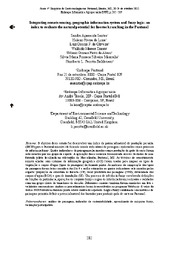Integrating remote sensing, geographic information system and fuzzy logic: an index to evaluate the natural potential for livestock ranching in the Pantanal.
Integrating remote sensing, geographic information system and fuzzy logic: an index to evaluate the natural potential for livestock ranching in the Pantanal.
Autoria: SANTOS, S. A.; LIMA, H. P. de; OLIVEIRA, L. O. F. de; TOMÁS, W. M.; ABREU, U. G. P. de; MASSRUHÁ, S. M. F. S.; PEROTTO-BALDIVIESO, H. L.
Resumo: Abstract: In this study, an index natural potential for livestock ranching (NPLR) at ranch level in the Pantanal wetland was obtained using landscape indicators combined with fuzzy inference process. Four landscape indicators related with livestock production were selected by an expertise group. The application of this approach was illustrated through a pilot ranch located in the Nhecolândia sub-region, Pantanal, MS. Remote Sensing (RS) and Geographic Information System (GIS) technologies were used to map the vegetation types and aquatic habitats (landscapes types) in this ranch. Landscape type?s composition metrics were obtained using the ArcGis 9 and were used to estimate the four indicators selected by expertise: forest cover proportion (FC); landscape productive value (LPV); diversity of aquatic habitats (DAH) and flooding degree (FD). Fuzzy inference process involving definitions of membership functions, fuzzy set operations and inference rule were run and validated with the participation of core stakeholders. Different scenarios also were simulated in batch and validated with the participation of stakeholders. Both procedures were performed by Webfuzzy software. The NPLR index value found in the pilot ranch was as expected by both expertise and stakeholders. Fuzzy logic combined with landscape metric seems to be suitable for the definition of the natural potential of ranches to produce livestock in the Pantanal.
Ano de publicação: 2012
Tipo de publicação: Artigo em anais e proceedings
Unidade: Embrapa Agricultura Digital
Palavras-chave: Análise de paisagem, Aprendizado de máquina fuzzy, Fuzzy machine learning, Geographic information systems, Indicador de sustentabilidade, Landscape analysis, Participatory validation, Remote sensing, Sensoriamento Remoto, Sistema de Informação Geográfica, Sustainability indicator, Validação participativa
Observações
1 - Por padrão são exibidas publicações dos últimos 20 anos. Para encontrar publicações mais antigas, configure o filtro ano de publicação, colocando o ano a partir do qual você deseja encontrar publicações. O filtro está na coluna da esquerda na busca acima.
2 - Para ler algumas publicações da Embrapa (apenas as que estão em formato ePub), é necessário ter, no celular ou computador, um desses softwares gratuitos. Sistemas Android: Google Play Livros; IOS: iBooks; Windows e Linux: software Calibre.
Acesse outras publicações
Acesse a Base de Dados da Pesquisa Agropecuária (BDPA) para consultar o acervo completo das bibliotecas da Embrapa.

